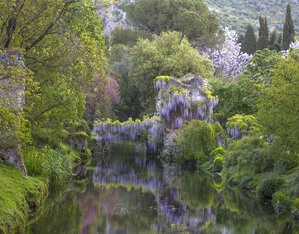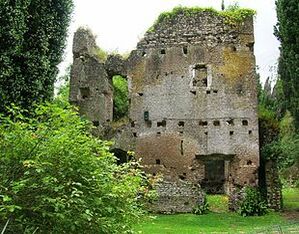Ninfa was many things before it became a garden: a place of a myth decanted in olden-day poems, a town at the heart of a major, productive landed estate, and then an icon of destruction and abandonment. For the last century, it has been a stunning garden reflected in the waters of its river, where exuberant flowers bloom in counterpoint to ruined towers and buildings.
Until the 15th century, Ninfa was a prosperous town full of roads, houses, towers, churches, bridges and mills. Then, malaria and never-ending battles led to it being abandoned and falling into ruin. Despite attempts by the owners, the Caetani family, to revive the built-up area, nature took over, invading and covering everything in ivy, honeysuckle and spontaneous flora. In the late 19th century, Onorato Caetani’s English-born wife, Ada Wilbraham, and their sons Gelasio and Roffredo, began to salvage some of the buildings, channel the waters and plant the first trees. Early in the 20th century, two women, Marguerite Chapin, Roffredo’s wife, and her daughter Lelia, created this magical place, where apple trees and ornamental cherry trees blossomed, climbing roses embraced ruined walls, and cascades of wisteria reflected in the clear waters of the river and springs, all in the shade of Mediterranean and exotic trees. They restored a number of structures, most notably the Tower, which became the emblem of Ninfa, as well as the Palazzo Comunale, where Lelia, the Caetani family’s last descendant, went to live. The hall, the former council chamber, became a site for artistic and cultural meetings that Lelia and her mother Marguerite arranged. In the midst of this luxuriant vegetation, thanks to the works of the writers who have loved and described it, present-day Ninfa has spawned its very own literary tradition.
Highlights

The Tower
On the flat Pontine plain, the tower’s 83-metre height ensures visibility from afar, while its bulk reflects in clear waters: immortalized in countless paintings, it has become the symbol of Ninfa. Work carried out in the early 20th century restored its Ghibelline battlements and ancient walls, testifying to its bellicose past.

Spectacular Trees
The garden is home to some highly unusual trees, including the Cotinus coggygria, or smoketree, with its cotton candy-like inflorescences; the Erythrina crista-galli, with scarlet flowers similar to tropical birds; the Gunnera manicata with its huge leaves, typical of South American river environments; and a Casuarina tenuissima of Australian origin.

Churches
Bearing witness to its earlier importance, as many as six churches dot the ruins of the age-old city that nestles in lush vegetation. Medieval architecture is eminently visible at the cathedral of Santa Maria Maggiore, San Pietro, and San Salvatore, characterized by elegant and slender two-light mullioned windows, as well as traces of frescoes.
 Giardino di Ninfa
Contacts
Giardino di Ninfa
Contacts
Contacts
Telephone:- +39 07731880888 (Il Call Center del Giardino di Ninfa è attivo il venerdì dalle ore 14 alle ore 18 e nelle giornate di apertura)
Address
Via Ninfina, 68
04012 , Cisterna di Latina (LT)
 Giardino di Ninfa
Opening times and prices
Giardino di Ninfa
Opening times and prices
Opening hours
- March to June: 9.00 am – 6.00 pm
- From July to September: 9.00 am – 6.30 pm
- October to November: 9.00 am – 3.30 pm
Visits leave from the entrance every 10 minutes, in order of arrival, according to the time slot chosen at the time of purchase. The visit lasts about 60 minutes. It is preferable to arrive 15 minutes before the start of your time slot.
Pricing
- Individual: € 15,00
- Minors: free entrance under 12 years old
- Conventions (FAI members, Lazio YOUthCard – EYCA, Dante Alighieri Society) : €12,00
- Disabled (severe disability > 75%) + Accompanying person purchase of entrance fee on site: € 8,00 each.
Online presale: + € 0,50 on the cost of the ticket.
 Giardino di Ninfa
How to get there
Giardino di Ninfa
How to get there
Address
Via Ninfina, 68
04012 , Cisterna di Latina (LT)
Latitude: 41.5817202
Longitude: 12.95175
How to arrive by road
- From Rome: to reach the Garden of Ninfa, take the SS 148 from the ring road and continue until the junction for Borgo Bainsizza.
- From Naples: take the A3 motorway towards Rome and exit at Frosinone.
How to arrive by train
From Napoli Centrale or Roma Termini you can take all the regional and intercity trains that stop at Latina Scalo station. From there it is possible, in about 10 minutes, to reach by taxi the Garden of Ninfa (Radio Taxi Latina tel. 0773.17.47 also active on Sundays).
How to arrive by bus
The area is not served by public transport, and can only be reached by own transport or taxi. The taxi service is about 7 km from Latina Scalo Station to the garden.
 Giardino di Ninfa
Services/Accessibility
Giardino di Ninfa
Services/Accessibility
Services
At the exit of the Garden there is a point of sale with gadgets.
There is a bar and refreshment area at the exit of the Garden.
Small dogs (not heavier than 5 kg) are allowed at the Garden of Ninfa and kept on a leash.
The Garden of Ninfa has a large parking area for cars, coaches and campers.
At Giardino di Ninfa is not guaranteed telephone line or wi-fi.
Accessibility
The Garden of Ninfa is easily accessible by wheelchairs and wheelchair paying attention to protruding roots, stones, low branches or other obstacles.
 Giardino di Ninfa
Private events
Giardino di Ninfa
Private events
 Giardino di Ninfa
Itineraries
Giardino di Ninfa
Itineraries
You could find the garden in these itineraries
 Favorite saving result
Favorite saving result
 Warning!
Warning!
You've have to sign up or sign in to add this element to your favorites.
